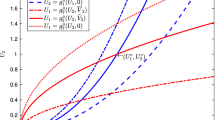Abstract
Based on the theories and approaches in biomechanics, the mechanism and pattern of niche construction were discussed systematically. Through establishing the spatial pattern of niche and its measuring-fitness formula, and the dynamic system models of single-and two-population with niche construction, including corresponding theoretical analysis and numerical simulation on their evolutionary dynamics of population and the mechanism of competitive coexistence, the co-evolutionary relationship between organisms and their environments was revealed. The results indicate that population dynamics is governed by positive feedback between primary ecological factors and resource content. Niche construction generates an evolutionary effect in system by influencing the fitness of population. A threshold effect exists in single population dynamic system. In dynamic system of two competitive populations, niche construction can lead to alternative competitive consequences, which may be a potential mechanism to explain the competitive coexistence of species.
Similar content being viewed by others
References
Grinnel J. Geography and evolution[J]. Ecology, 1924, 5(1): 225–229.
Elton C. Animal Ecology[M]. Macmillan, New York, 1957, 209–232.
Hutchinson G E. Concluding remarks[J]. Cold Spring Harbor Symposia on Quantitative Biology, 1957, 22(2): 415–427.
MarArthur R H, Levins R. The limiting similarity convergence and divergence of coexisting species[J]. American Naturalist, 1967, 101(3): 377–385.
van Valen L M. Morphological variation and width of ecological niche[J]. American Naturalist, 1965, 99(3): 377–390.
Levins R. Evolution in Changing Environments[M]. Princeton University Press, Princeton, 1968, 178–213.
May R M. On the theory of niche overlap[J]. Theoretical Population Biology, 1974, 5(1): 297–332.
Laland K N, Odling-Smee F J, Feldman M W. Evolutionary consequences of niche construction: a theoretical investigation using two-locus theory[J]. Journal of Evolutionary Biology, 1996, 9(3): 293–316.
Jones C G, Lawton J H, Shachak M. Positive and negative effects of organisms as physical ecosystem engineers[J]. Ecology, 1997, 78(5): 1946–1957.
Li Zizhen, Xu Cailin, Wang Wanxiong. Two-dimensional nonlinear dynamic system model of interspeciesfic interaction and numerical simulation research on it[J]. Applied Mathematics and Mechanics (English Edition), 2003, 24(7): 836–844.
Author information
Authors and Affiliations
Corresponding author
Additional information
Communicated by YEH Kai-yuan
Project supported by the National Natural Science Foundation of China (no.30470298) and the National Social Science Foundation of China (No.04AJL007)
Rights and permissions
About this article
Cite this article
Li, Zz., Han, Xz. & Li, Wl. Evolutionary dynamic model of population with niche construction and its application research. Appl Math Mech 27, 327–334 (2006). https://doi.org/10.1007/s10483-006-0307-1
Received:
Revised:
Issue Date:
DOI: https://doi.org/10.1007/s10483-006-0307-1




